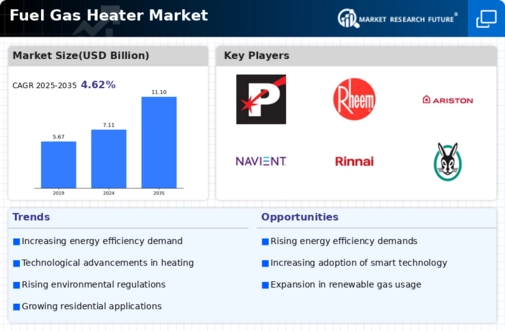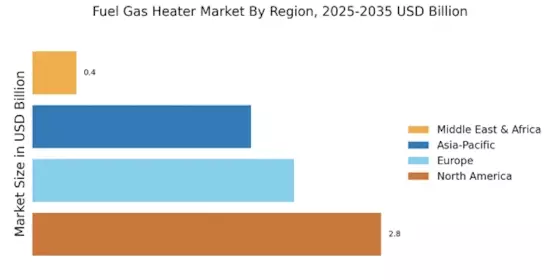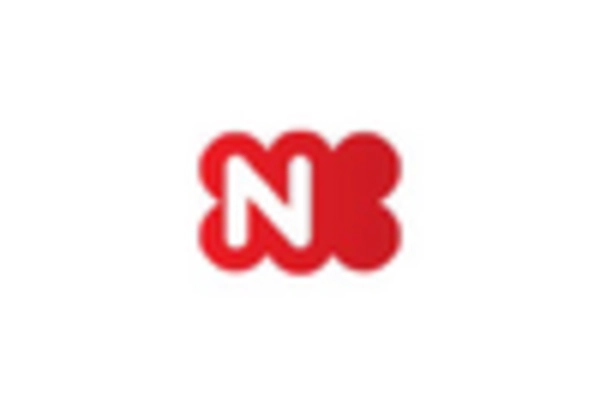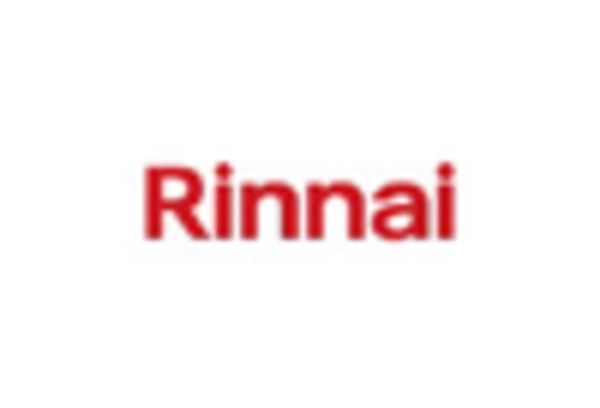Regulatory Support for Clean Energy Solutions
The Fuel Gas Heater Market is benefiting from a favorable regulatory environment that supports the transition to cleaner energy solutions. Governments worldwide are implementing stringent regulations aimed at reducing carbon emissions and promoting the use of cleaner fuels. This regulatory support encourages consumers and businesses to invest in fuel gas heaters, which are often more environmentally friendly compared to traditional heating systems. Recent statistics suggest that regions with robust regulatory frameworks have seen a 15% increase in the adoption of fuel gas heaters over the past few years. As regulations continue to evolve, the market is likely to witness sustained growth driven by compliance and innovation.
Rising Construction and Renovation Activities
The Fuel Gas Heater Market is poised for growth due to the rising construction and renovation activities across various sectors. As new residential and commercial buildings are constructed, there is an increasing need for efficient heating solutions. Additionally, renovation projects often involve upgrading existing heating systems to more efficient fuel gas heaters. Market analysis indicates that the construction sector is projected to grow at a rate of 5% annually, which directly correlates with the demand for fuel gas heaters. This trend is further amplified by the growing emphasis on energy-efficient building practices, making fuel gas heaters a preferred choice for many builders and homeowners.
Technological Advancements in Heating Systems
Technological advancements play a pivotal role in shaping the Fuel Gas Heater Market. Innovations such as improved burner designs, enhanced heat exchangers, and smart controls are revolutionizing the way fuel gas heaters operate. These advancements not only increase efficiency but also improve safety and user convenience. For instance, the integration of smart technology allows users to monitor and control their heating systems remotely, leading to optimized energy usage. Market data indicates that the adoption of smart heating solutions is expected to grow by over 25% in the coming years, reflecting a shift towards more intelligent and responsive heating systems. This trend is likely to propel the fuel gas heater market forward.
Increasing Demand for Energy-Efficient Solutions
The Fuel Gas Heater Market is experiencing a notable surge in demand for energy-efficient heating solutions. As consumers become more environmentally conscious, they are increasingly seeking products that minimize energy consumption while maximizing performance. This trend is supported by various government initiatives aimed at promoting energy efficiency, which have led to a rise in the adoption of fuel gas heaters. According to recent data, energy-efficient models can reduce energy costs by up to 30%, making them an attractive option for both residential and commercial users. Consequently, manufacturers are focusing on developing advanced technologies that enhance the efficiency of fuel gas heaters, thereby driving growth in the market.
Consumer Preference for Cost-Effective Heating Solutions
Consumer preference for cost-effective heating solutions is a significant driver in the Fuel Gas Heater Market. As energy prices fluctuate, consumers are increasingly looking for heating options that provide reliable performance without incurring high operational costs. Fuel gas heaters are often perceived as a more economical choice compared to electric or oil-based heating systems. Recent market data indicates that fuel gas heaters can offer savings of up to 20% in heating costs, making them an attractive option for budget-conscious consumers. This growing preference is likely to sustain demand for fuel gas heaters, as more individuals and businesses seek to balance cost and efficiency in their heating solutions.


















Leave a Comment